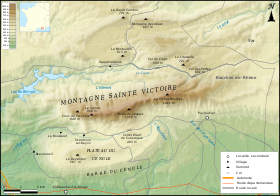Montagne Sainte-Victoire

(exactly behind its tower the 19 meter high mountain cross Croix de Provence ).
Montagne Sainte-Victoire also Venturi / Santa Venturi , Ventùri / Santo Ventùri ( Provencal ) is a French limestone mountain range in the south of Provence , which extends from near Aix en Provence over 18 kilometers from west to east. Its highest point is the Pic des Mouches in the eastern part with a height of 1,011 meters.
The mountains became famous through the painter Paul Cézanne , who was able to see them from his nearby house in Les Lauves in the north of Aix-en-Provence and who took them as the subject of numerous paintings.
History and tourism
Originally called Montagne de la Victoire , the Christians in the Middle Ages called the mountain range Sainte-Venture . In the 13th century a chapel was built on the summit. The mountain range was given its current name in the 17th century.
In 1989 a fire destroyed 50 km² of the vegetation on the south side of the mountain. Many conifers have already been planted, but the old condition as it was before the fire has not yet been achieved. During the summer, access to the mountain is restricted or prohibited depending on the weather. During the period of free access, the Sainte Victoire Mountains are a popular destination for those who enjoy hiking , mountaineering , paragliding and, to a lesser extent, caving . Around 700,000 hikers come here every year. The natural and cultural landscape of the Montagne Sainte-Victoire has been a mixed site on France's list of proposed UNESCO World Heritage sites since 1996 .
Artist
In addition to Paul Cézanne, the Montagne Sainte-Victoire has also been a source of inspiration for other artists and writers, for example:
- the painter Pierre-Auguste Renoir
- the painter Pablo Picasso , who in 1958 bought the Château de Vauvenargues , which is located in the town of the same name on the northern edge of the mountains, and used a studio there between 1959 and 1962. After he died in 1973, he was buried in the park.
- the painter Wassily Kandinsky
- the writer Peter Handke with The Teaching of Sainte-Victoire (1980)
- the writer Guy Gavriel Kay with Ysabel (2007)
Web links
Individual evidence
- ^ Montagne Sainte-Victoire et sites cézaniens. UNESCO World Heritage Center, September 20, 1996, accessed January 15, 2018 (French).
Coordinates: 43 ° 32 ′ 21 ″ N , 5 ° 38 ′ 43 ″ E



